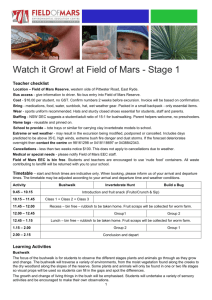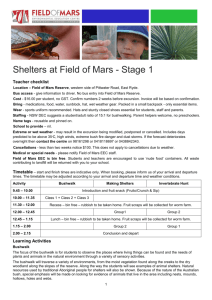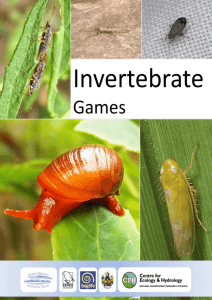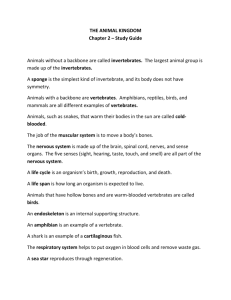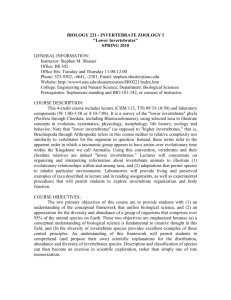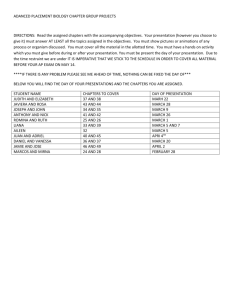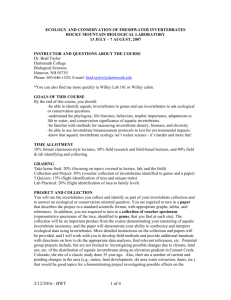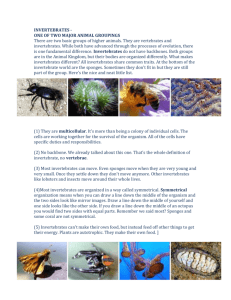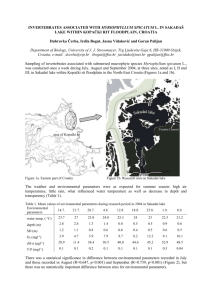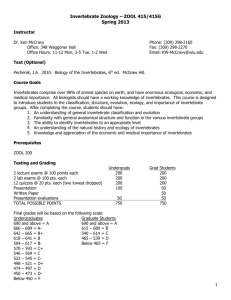Invertebrate Art at Field of Mars
advertisement
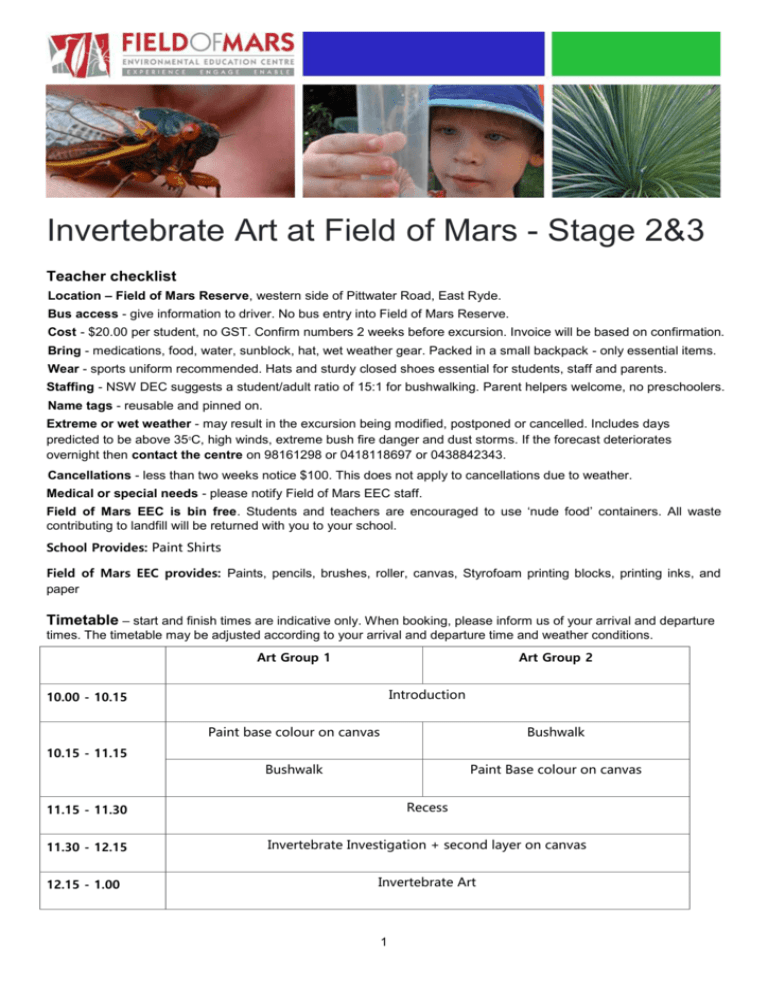
Invertebrate Art at Field of Mars - Stage 2&3 Teacher checklist Location – Field of Mars Reserve, western side of Pittwater Road, East Ryde. Bus access - give information to driver. No bus entry into Field of Mars Reserve. Cost - $20.00 per student, no GST. Confirm numbers 2 weeks before excursion. Invoice will be based on confirmation. Bring - medications, food, water, sunblock, hat, wet weather gear. Packed in a small backpack - only essential items. Wear - sports uniform recommended. Hats and sturdy closed shoes essential for students, staff and parents. Staffing - NSW DEC suggests a student/adult ratio of 15:1 for bushwalking. Parent helpers welcome, no preschoolers. Name tags - reusable and pinned on. Extreme or wet weather - may result in the excursion being modified, postponed or cancelled. Includes days predicted to be above 35 C, high winds, extreme bush fire danger and dust storms. If the forecast deteriorates overnight then contact the centre on 98161298 or 0418118697 or 0438842343. 0 Cancellations - less than two weeks notice $100. This does not apply to cancellations due to weather. Medical or special needs - please notify Field of Mars EEC staff. Field of Mars EEC is bin free. Students and teachers are encouraged to use ‘nude food’ containers. All waste contributing to landfill will be returned with you to your school. School Provides: Paint Shirts Field of Mars EEC provides: Paints, pencils, brushes, roller, canvas, Styrofoam printing blocks, printing inks, and paper Timetable – start and finish times are indicative only. When booking, please inform us of your arrival and departure times. The timetable may be adjusted according to your arrival and departure time and weather conditions. Art Group 1 Art Group 2 Introduction 10.00 - 10.15 Paint base colour on canvas Bushwalk Bushwalk Paint Base colour on canvas 10.15 - 11.15 11.15 - 11.30 Recess 11.30 - 12.15 Invertebrate Investigation + second layer on canvas 12.15 - 1.00 Invertebrate Art 1 1.00 - 1.30 Lunch 1.30 - 2.30 Invertebrate Art 2.30 Conclusion & depart Learning Activities Bushwalk The focus of the bushwalk is for students to observe the different places in the natural environment that invertebrates can be found. The bushwalk will traverse a variety of environments, from the moist vegetation found along the creeks to the dry woodland along the slopes of the reserve. Many invertebrate species will remain hidden during the walk so particular emphasis will be placed on looking for animal evidence such as tracks, scats and sounds. The needs of invertebrates in their environment and the important role of invertebrates in the bush will be emphasised. Students will undertake a variety of sensory activities and be encouraged to make their own observations. Invertebrate Hunt The focus of this session is for students to work cooperatively to conduct an investigation, using simple equipment, to explore and answer the question: What invertebrates live in the leaf litter? Students will work in small groups to search for and collect leaf litter invertebrates in the gardens surrounding the education centre. Collected specimens will then be examined using personal magnifiers and identified using ID charts. Some of the collected invertebrates will be magnified onto the IWB and features and adaptations explained to the students. Invertebrate Art Students examine the features of one or two chosen invertebrates up close, using a range of magnifying equipment, paying particular attention to detail including numbers of legs, sections of the body, colour, shape, structure, texture and patterns found on the invertebrate. After careful observation and study of an invertebrate, students will create an artwork on canvas. This will involve the use of a variety of media including rollers, pencil, brushes and paint. Upon completion the canvases will be displayed for a short exhibition in the afternoon allowing students to admire and evaluate their work. If time permits, the students will be able to create a block print based on their observations of a chosen invertebrate. These prints are made by drawing into a Styrofoam block. Ink is rolled onto the block that is then pressed onto paper to create an artwork. Supporting Resources Invertebrate websites - http://fieldofmarseec.nsw.edu.au/resources/general/ Field of Mars Multitouch Books – https://itunes.apple.com/au/book/phasmids/id712107565?mt=13 Field of Mars iTunes U Course - https://itunes.apple.com/au/course/investigating-invertebrates/id725296002 Field of Mars Video Conferences - http://fieldofmarseec.nsw.edu.au/connected-learning/connected-classroomlessons/ Syllabus Links Environmental Education Objectives Students will develop: knowledge and understandings about: the nature and function of ecosystems and how they are interrelated (K1) skills in: adopting behaviours and practices that protect the environment (S5) values and attitudes relating to: a respect for life on Earth (V1) 2 an appreciation of their cultural heritage (V2) Science K-10 Outcomes Stage 2 & 3 Science K-10 Content Stage 2 & 3 ST2-10LW describes that living things have life cycles, can be distinguished from non-living things and grouped, based on their observable features Living things can be grouped on the basis of observable features and can be distinguished from non-living things. (ACSSU044) ST2-11LW describes ways that science knowledge helps people understand the effect of their actions on the environment and on the survival of living things Living things, including plants and animals, depend on each other and the environment to survive. (ACSSU073) A student: Living things have structural features and adaptations that help them to survive in their environment. (ACSSU043) ST3-10LW describes how structural features and other adaptations of living things help them to survive in their environment A student: identify and use patterns in the observable features of living things to group them, by using tables, diagrams or flowcharts identify some factors in the local environment that are needed by plants and animals for survival observe and describe the structural features of some native Australian animals and plants Students question and predict by: predicting what the findings of an investigation might be (ACSIS231, ACSIS232) ST3-4WS investigates by posing questions, including testable questions, making predictions and gathering data to draw evidence-based conclusions and develop explanations. Students conduct investigations by: Creative Arts Outcomes Stage 2 & 3 Creative Arts Content Stage 2 & 3 working individually and collaboratively in conducting a range of appropriate investigation methods, including fair tests, to answer questions or solve problems accurately observing, measuring and recording data, using digital technologies as appropriate (ACSIS087, ACSIS104) VAS2.1 Represents the qualities of experiences and things that are interesting or beautiful by choosing among aspects of subject matter VAS2.2 Uses the forms to suggest the qualities of subject matter, Students will be able to explore a variety of artmaking conventions related to observation drawing, printing and painting. Extend the students’ knowledge and understanding of a variety of media. Students will have the opportunity to look at the art making practices of other artists, from a variety of cultures, who have explored invertebrates as their subject matter e.g. Ancient Egypt, Chinese painting, Dutch Still-life, and Aboriginal painting. VAS3.1 Investigates subject matter in an attempt to represent likenesses of things in the world. VAS3.2 Makes artworks for different audiences, assembling materials Study invertebrates in their environment and look at the details which often go unnoticed. Observe and study from nature the characteristics of invertebrates and focus on details including size, shape, colour and texture. Students: Study invertebrates in their environment and look at the details which often go unnoticed. Observe and study from nature the characteristics of invertebrates and focus on details including size, shape, colour and texture. Students will be able to explore a variety of art-making conventions related to observation drawing and printing. Extend the students’ knowledge and understanding of a variety of 3 in a variety of ways. media. Students will have the opportunity to look at the art making practices of other artists, from a variety of cultures, who have explored invertebrates as their subject matter e.g. Ancient Egypt, Chinese painting, Dutch Still-life, and Aboriginal painting. 4
